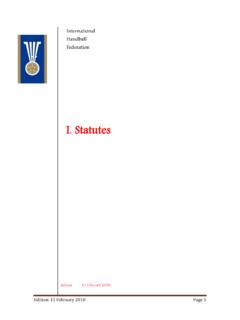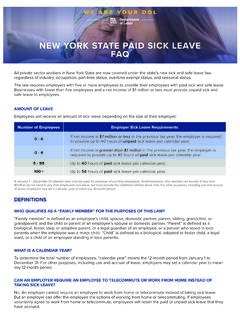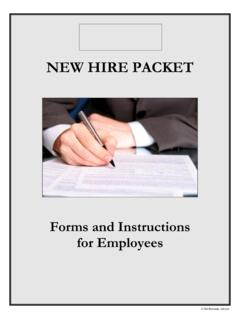Transcription of New Rules of the Game - IHF
1 Edition: 1 July 2016 Page 1 International Handball Federation IX. Rules of the Game a) Indoor Handball Edition: 1 July 2016 Edition: 1 July 2016 Page 2 Table of contents Foreword 4 Rules of the Game 5 1. Playing Court 5 2. Playing Time, Final Signal and Time-Out 10 3. The Ball 13 4. The Team, Substitutions, Equipment, Player Injuries 14 5. The Goalkeeper 18 6. The Goal Area 20 7. Playing the Ball, Passive Play 22 8. Fouls and Unsportsmanlike Conduct 25 9. Scoring 31 10. The Throw-Off 33 11. The Throw-In 34 12. The Goalkeeper Throw 35 13. The Free Throw 36 14. The 7-Metre Throw 39 15. General Instructions on the Execution of the Throws 41 (Throw-Off, Throw-In, Goalkeeper Throw, Free Throw and 7-Metre Throw) 16. The Punishments 44 17. The Referees 48 18.
2 The Timekeeper and the Scorekeeper 50 Hand Signals 51 Clarifications to the Rules of the Game 61 Edition: 1 July 2016 Page 3 Substitution Area Regulations 76 Guidelines and Interpretations 79 Guidelines for Playing Courts and Goals 97 Edition: 1 July 2016 Page 4 Foreword These Rules of the Game will take effect on 1 July 2016. The Rules Text, the Comments, the IHF Hand Signals, the Clarifications to the Rules of the Game, and the Substitution Area Regulations are all components of the overall Rules . Please also note the integrated Guidelines and Interpretations that give additional guidance on the application of certain Rules . The former version published in 2010 with updates is no longer valid. The Guidelines and Interpretations will be expanded, if required. The Guidelines for Playing Courts and Goals , which are simply included in the rule book for the convenience of the users of that text, are not an integral part of the Rules .
3 Note: For the sake of simplicity, this rule book generally uses the male form of words with respect to players, officials, referees and other persons. However, the Rules apply equally to male and female participants, except as regards the Rules for the size of the balls to be used (see Rule 3). Edition: 1 July 2016 Page 5 RULE 1 Playing Court 1:1 The playing court (see diagram 1) is a 40 metres long and 20 metres wide rectangle, consisting of two goal areas (see 1:4 and 6) and a playing area. The longer boundary lines are called side lines, and the shorter ones are called goal lines (between the goalposts) or outer goal lines (on either side of the goal). There should be a safety zone surrounding the playing court, with a width of at least 1 metre along the side lines and 2 metres behind the goal lines.
4 The characteristics of the playing court must not be altered during the game in such a way that one team gains an advantage. 1:2 A goal (see diagrams 2a and 2b) is placed in the centre of each outer goal line. The goals must be firmly attached to the floor or to the walls behind them. They have an interior height of 2 metres and a width of 3 metres. The goalposts are joined by a horizontal crossbar. The rear side of the goalposts shall be in line with the rear edge of the goal line. The goalposts and the crossbar must have an 8cm square cross section. On the three sides which are visible from the court they must be painted in bands of two contrasting colours, which also contrast clearly with the background. The goals must have a net, that should be attached in such a way that a ball thrown into the goal normally remains in the goal.
5 1:3 All lines on the court are fully part of the area that they enclose. The goal lines shall be 8cm wide between the goalposts (see diagram 2a), whereas all other lines shall be 5cm wide. Lines between two adjacent areas may be replaced with a difference in colours between the adjacent areas of the floor. 1:4 In front of each goal there is a goal area (see diagram 5, page 100). The goal area is defined by the goal-area line (6-metre line), which is drawn as follows: a) a 3 metres long line directly in front of the goal; this line is parallel to the goal line and 6 metres away from it (measured from the rear edge of the goal line to the front edge of the goal-area line); b) two quarter circles, each with a radius of 6 metres (measured from the rear inner corner of the goalposts), connecting the 3 metres long line with the outer goal line (see diagrams 1 and 2a).
6 1:5 The free throw line (9-metre line) is a broken line, drawn 3 metres outside the goal-area line. Both the segments of the line and the spaces between them measure 15cm (see diagram 1). Edition: 1 July 2016 Page 6 1:6 The 7-metre line is a 1 metre long line, directly in front of the goal. It is parallel to the goal line and 7 metres away from it (measured from the rear edge of the goal line to the front edge of the 7-metre line); (see diagram 1). 1:7 The goalkeeper s restraining line (the 4-metre line) is a 15cm long line, directly in front of the goal. It is parallel to the goal line and 4 metres away from it (measured from the rear edge of the goal line to the front edge of the 4-metre line) (see diagram 1). 1:8 The centre line connects the midpoints of the two side lines (see diagrams 1 and 3).
7 1:9 The substitution line (a segment of the side line) for each team extends from the centre line to a point at a distance of metres from the centre line. This end point of the substitution line is enhanced by a line which is parallel to the centre line, extending 15cm inside the sideline and 15cm outside the sideline (see diagrams 1 and 3). Note: More detailed technical requirements for the playing court and the goals can be found in the Guidelines for Playing Courts and Goals, starting on page 97. Edition: 1 July 2016 Page 7 Diagram 1: The playing court Dimensions indicated in cm. Goal area: see also diagram 5 (page 100) Edition: 1 July 2016 Page 8 Diagram 2a: The goal Edition: 1 July 2016 Page 9 Diagram 2b: The goal lateral view Diagram 3: Substitution lines and substitution area The table for timekeeper and scorekeeper and the benches for substitutes have to be placed in such a way that the scorekeeper/timekeeper can see the substitution lines.
8 The table should be placed closer to the side line than the benches, but at least 50cm outside the side line. Edition: 1 July 2016 Page 10 RULE 2 Playing Time, Final Signal and Time-Out Playing Time 2:1 The normal playing time for all teams with players of age 16 and above is 2 halves of 30 minutes. The half-time break is normally 10 minutes. The normal playing time for youth teams is 2 x 25 minutes in age group 12-16 and 2 x 20 minutes in age group 8-12. In both cases the half-time break is normally 10 minutes. Note: IHF, continental confederations and national federations have the right to apply deviating regulations in their areas of responsibility regarding the half-time break. The maximum half-time break is 15 minutes. 2:2 overtime is played, following a 5-minute break, if a game is tied at the end of the regular playing time and a winner has to be determined.
9 The overtime period consists of 2 halves of 5 minutes, with a 1-minute half-time break. If the game is again tied after a first overtime period, a second period is played after a 5-minute break. This overtime period also has 2 halves of 5 minutes, with a 1-minute half-time break. If the game is still tied, the winner will be determined in accordance with the Rules for the particular competition. In the case that the decision is to use 7-metre throwing as tie-breaker to decide a winner, the procedures indicated below shall be followed. Comment: If 7-metre throwing is used as a tie-breaker, players who are not suspended or disqualified at the end of the playing time are entitled to participate (see also Rule 4:1, 4th paragraph). Each team nominates 5 players. These players make one throw each, alternating with the players of the other team.
10 The teams are not required to predetermine the sequence of their throwers. Goalkeepers may be freely chosen and substituted among the players eligible to participate. Players may participate in the 7-metre throwing as both throwers and goalkeepers. The referees decide which goal is used. The referees make a coin toss, and the winning team chooses whether they wish to throw first or last. The opposite sequence is used for all subsequent throws, if the throwing has to continue because the score is still tied after the first five throws each. For such a continuation, each team shall again nominate five players. All or some of them may be the same as in the first round. This method of nominating five players at a time continues as long as it is necessary.








